
Rimini is a city in the Emilia-Romagna region of Northern Italy.

Domenico di Tommaso Curradi di Doffo Bigordi, professionally known as Domenico Ghirlandaio, was an Italian Renaissance painter born in Florence. Ghirlandaio was part of the so-called "third generation" of the Florentine Renaissance, along with Verrocchio, the Pollaiolo brothers and Sandro Botticelli. Ghirlandaio led a large and efficient workshop that included his brothers Davide Ghirlandaio and Benedetto Ghirlandaio, his brother-in-law Bastiano Mainardi from San Gimignano, and later his son Ridolfo Ghirlandaio. Many apprentices passed through Ghirlandaio's workshop, including the famous Michelangelo. His particular talent lay in his ability to posit depictions of contemporary life and portraits of contemporary people within the context of religious narratives, bringing him great popularity and many large commissions.

Romagna is an Italian historical region that approximately corresponds to the south-eastern portion of present-day Emilia-Romagna in northern Italy.

Vittore Carpaccio (UK: /kɑːrˈpætʃ oʊ/, US: /-ˈpɑːtʃ-/, Italian: [vitˈtoːre karˈpattʃo]; was an Italian painter of the Venetian school who studied under Gentile Bellini. Carpaccio was largely influenced by the style of the early Italian Renaissance painter Antonello da Messina, as well as Early Netherlandish painting. Although often compared to his mentor Gentile Bellini, Vittore Carpaccio's command of perspective, precise attention to architectural detail, themes of death, and use of bold color differentiated him from other Italian Renaissance artists. Many of his works display the religious themes and cross-cultural elements of art at the time; his portrayal of St. Augustine in His Study from 1502, reflects the popularity of collecting "exotic" and highly desired objects from different cultures.

Pesaro is a comune (municipality) in the Italian region of Marche, capital of the province of Pesaro and Urbino, on the Adriatic Sea. According to the 2011 census, its population was 95,011, making it the second most populous city in the Marche, after Ancona. Pesaro was dubbed the "Cycling City" by the Italian environmentalist association Legambiente in recognition of its extensive network of bicycle paths and promotion of cycling. It is also known as "City of Music", for it is the birthplace of the composer Gioachino Rossini. In 2015 the Italian Government applied for Pesaro to be declared a "Creative City" in UNESCO's World Heritage Sites. In 2017 Pesaro received the European City of Sport award together with Aosta, Cagliari and Vicenza.

Vincenzo Foppa was an Italian painter from the Renaissance period. While few of his works survive, he was an esteemed and influential painter during his time and is considered the preeminent leader of the Early Lombard School. He spent his career working for the Sforza family, Dukes of Milan, in Pavia, as well as various other patrons throughout Lombardy and Liguria. He lived and worked in his native Brescia during his later years.

Comacchio is a town and comune of Emilia Romagna, Italy, in the province of Ferrara, 48 kilometres (30 mi) from the provincial capital Ferrara. It was founded about two thousand years ago; across its history it was first governed by the Exarchate of Ravenna, then by the Duchy of Ferrara, and eventually returned to be part of the territories of the Papal States. For its landscape and its history, it is considered one of the major centres of the Po delta.

Giovanni Girolamo Savoldo, also called Girolamo da Brescia, was an Italian High Renaissance painter active mostly in Venice, although he also worked in other cities in northern Italy. He is noted for his subtle use of color and chiaroscuro, and for the sober realism of his works, which are mostly religious subjects, with a few portraits. His portraits are given interest by their accessories or settings; "some even look like extracts from larger narratives".

The Bridge of Tiberius, historically also the Bridge of Augustus or the Bridge of Saint Julian, is a Roman bridge in Rimini, in the region of Emilia-Romagna, northern Italy.

The Madonna dell'Orto is a church in Venice, Italy, in the sestiere of Cannaregio. This was the home parish of Tintoretto and holds a number of his works as well as his tomb.

The Church of St Job is a 15th-century Roman Catholic church located overlooking the campo of the same name, known as Sant'Agiopo in Venetian dialect, on the south bank of the Cannaregio canal near Ponte dei Tre Archi in the sestiere of Cannaregio of Venice, northern Italy,
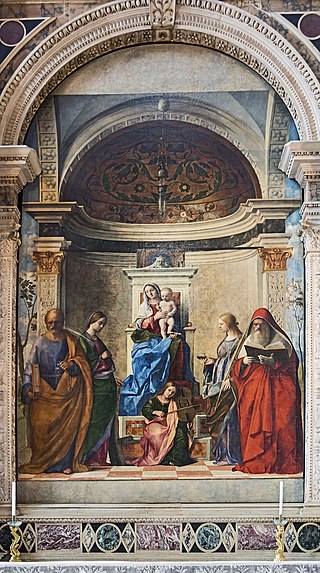
The San Zaccaria Altarpiece is a painting by the Italian Renaissance painter Giovanni Bellini, executed in 1505 and located in the church of San Zaccaria, Venice.

Sant'Agostino is a Romanesque-Gothic-style Roman Catholic church located in Via Cairoli in Rimini, Italy. It is one of the city's oldest extant church buildings.
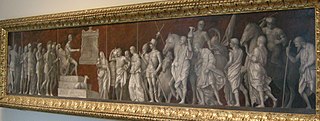
The Continence of Scipio or An Episode from the Life of Publius Cornelius Scipio is a painting in oils on canvas by the Italian Renaissance artist Giovanni Bellini, dating to 1507–08 and now in the National Gallery of Art in Washington, D.C.
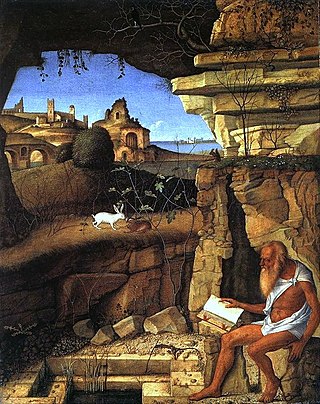
St. Jerome in the Desert is a 1505 oil-on-canvas painting by the Italian Renaissance master Giovanni Bellini, now in the National Gallery of Art in Washington. Little remains of the signature on the first rock in the left foreground, but it has been confirmed as genuine during restoration and can be reconstructed as "[Johannes Bellinu]s. 1505". This is problematic, since the work's general style is linked to fashions no later than 1490, whereas Bellini's style of figures and landscapes had already begun to be influenced by Giorgione by 1500, with the backgrounds more fused and unified in terms of atmosphere. The composition makes it more analogous to his earlier works, such as the c. 1480 St. Jerome in the Desert. The Washington work may have been a collaboration, a work completed by a pupil in Bellini's studio or left incomplete and only finished by Bellini himself much later.

The Pesaro Altarpiece is an oil-on-panel painting by the Italian artist Giovanni Bellini, dated to some time between 1471 and 1483. It is considered one of Bellini's first mature works, though there are doubts on its dating and on who commissioned it. The work's technique is not only an early use of oils but also of blue smalt, a by-product of the glass industry. It had already been used in the Low Countries in Bouts' 1455 The Entombment, but this marked smalt's first use in Italian art, twenty years before Leonardo da Vinci used it in Ludovico il Moro's apartments in Milan in 1492. Bellini also uses the more traditional lapis lazuli and azurite for other blues in the work.
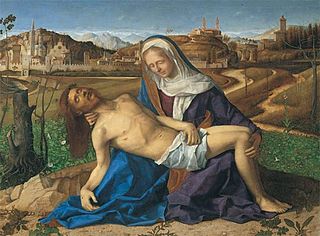
The Martinengo Pietà is an oil painting on panel of c. 1505 by the Italian Renaissance master Giovanni Bellini, signed on the rock to the left of the Virgin. It was previously in the collections of the Martinengo family and of Donà delle Rose and is now in the Gallerie dell'Accademia in Venice.

The Portrait of Georg Fugger is a 1474 oil-on-panel portrait painting by the Italian Renaissance artist Giovanni Bellini, now in the Norton Simon Museum in Pasadena, United States. It is his earliest surviving portrait and one of the first works in oil by an Italian artist.
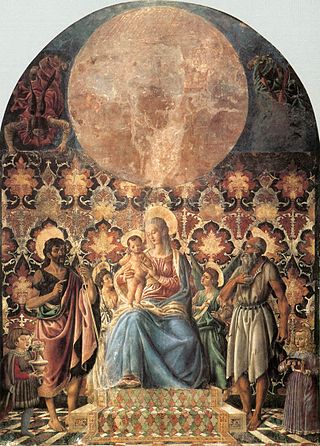
The Casa Pazzi Madonna is a fresco fragment by Andrea del Castagno, created in 1443, originally the altarpiece of the chapel of Santa Brigida at the castello del Trebbio in the Pontassieve district, then owned by Andrea de' Pazzi, hence the painting's name. Removed from the wall in the 19th century it is now in the Contini Bonacossi collection within the Uffizi in Florence.




















